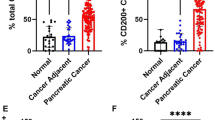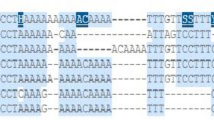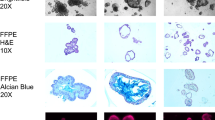Abstract
Background
Tenascin-C is an extracellular matrix protein forming various types of spliced variants. Low molecule variants are transiently present, but large spliced variants are predominantly overexpressed in proliferative processes or tumorigenesis in some varieties of cancer. However, the detection of the plasma level of large tenascin-C spliced variant (L-Tn-CSV) in colorectal cancer (CRC) has not been clarified. This study was performed to validate elevated plasma L-Tn-CSV levels as a possible biomarker for CRC.
Materials and Methods
Plasma samples were obtained before resection and from time to time postoperatively and stored at −80°C until assay. Plasma L-Tn-CSV levels were evaluated in patients with primary (n = 162) and with recurrent (n = 20) CRC, including 48 healthy volunteers, measured by ELISA.
Results
The average plasma L-Tn-CSV concentrations of patients with primary CRC were 5,260 ± 3,243.3 pg/ml and of patients with recurrent CRC 4,106 ± 2,261.1 pg/ml, which were significantly elevated in comparison with those of healthy volunteers (2,364.3 ± 7,49.6). The sensitivity for detecting CRC using plasma L-Tn-CSV was 56.6%, based on the mean ± 2 SD of the concentrations of healthy controls (3,863.5), which was significantly higher than CEA (40.1%) and CA19-9 (23.6%). No obvious associations were evident between plasma L-Tn-CSV status and values of CEA and CA19-9 respectively. Statistically significant differences in plasma L-Tn-CSV were observed depending on tumor depth, lymph node metastasis, and TNM stage. Negative conversions of plasma L-Tn-CSV levels 6 months after resection were significantly higher in the completely curative resection group than in the non-curative groups (P < 0.001).
Conclusion
The plasma L-Tn-CSV may serve very well as a useful biomarker for tumor staging and postoperative monitoring of preoperatively positive CRC that is independent and exceeds conventional tumor markers.


Similar content being viewed by others
References
Chiquet-Ehrismann R, Mackie EJ, Pearson CA, et al. Tenascin: an extra cellular matrix protein involved in tissue interactions during fetal development and oncogenesis. Cell 1986;47:131–139
Yoshida T, Yoshimura E, Numata H, et al. Involvement of tenascin-C in proliferation and migration of laryngeal carcinoma cells. Virchows Arch 1999;435:496–500
Jones FS, Jones PL. The tenascin family of ECM glycoproteins: structure, function, and regulation during embryonic development and tissue remodeling. Dev Dyn 2000;218:235–259
Nies DE, Hemesath TJ, Kim JH, et al. The complete cDNA sequence of human hexabrachion (tenascin). A multidomain protein containing unique epidermal growth factor repeats. J Biol Chem 1991;266:2818–2823
Jones PL, Jones FS. Tenascin-C in development and disease: gene regulation and cell function. Matrix Biol 2000;19:581–596
Hindermann W, Berndt A, Borsi L, et al. Synthesis and protein distribution of the unspliced large tenascin-C isoform in oral squamous cell carcinoma. J Pathol 1999;189:475–480
Latijnhouwers MA, de Jongh GJ, Bergers M, et al. Expression of tenascin-C spliced variants by human skin cells. Arch Dermatol Res 2000;292:446–454
Tsunoda T, Inada H, Kalembeyi I, et al. Involvement of large tenascin-C splice variants in breast cancer progression. Am J Pathol 2003;162:1857–1867
Hasegawa M, Hirata H, Sudo A, et al. Tenascin-C concentration in synovial fluid correlates with radiographic progression of knee osteoarthritis. J Rheumatol 2004;31:2021–2026
Emoto K, Yamada Y, Sawada H, et al. Annexin II overexpression correlates with stromal tenascin-C overexpression: a prognostic marker in colorectal carcinoma. Cancer 2001;92:1419–1426
Iskaros BF, Tanaka KE, Hu X, et al. Morphologic pattern of tenascin as a diagnostic biomarker in colon cancer. J Surg Oncol 1997;64:98–101
Dueck M, Riedl S, Hinz U, et al. Detection of tenascin-C isoforms in colorectal mucosa, ulcerative colitis, carcinomas and liver metastases. Int J Cancer 1999;82:477–483
Sobin LH, Witteking C (eds) UICC TNM Classification of Malignant Tumors, 6th edn. New York, Wiley, 2002
Japanese Society for Cancer of the Colon and Rectum. Japanese Classification of Colorectal Carcinoma. First English edn. Tokyo: Kanehara, 1998
Matsumoto K, Hiraiwa N, Yoshiki A et al. Tenascin-C expression and splice variant in habu snake venom-induced glomerulonephritis. Exp Mol Pathol 2002;72:186–195
Joester A, Faissner A. Evidence for combinatorial variability of tenascin-C isoforms and developmental regulation in the mouse central nervous system. J Biol Chem 1999;274:17144–17151
Aufderheide E, Ekblom P. Tenascin during gut development: appearance in the mesenchyme, shift in molecular forms, and dependence on epithelial-mesenchymal interactions. J Cell Biol 1988;107:2341–2349
Jahkola T, Toivonen T, Virtanen I, et al. Tenascin-C expression in invasion border of early breast cancer: a predictor of local and distant recurrence. Br J Cancer 1998;78:1507–1513
Kressner U, Lindmark G, Tomasini-Johansson B, et al. Stromal tenascin distribution as a prognostic marker in colorectal cancer. Br J Cancer 1997;76:526–530
Sugawara I, Hirakoshi J, Kusakabe M, et al. Relationships among tenascin expression, DNA ploidy patterns, and multidrug resistance gene product (P-glycoprotein) in human colon carcinoma. Jpn J Cancer Res 1993;84:703–707
Pilch H, Schaffer U, Schlenger K, et al. Expression of tenascin in human cervical cancer—association of tenascin expression with clinicopathological parameters. Gynecol Oncol 1999;73:415–421
Wiksten JP, Lundin J, Nordling S, et al. Tenascin-C expression correlates with prognosis in gastric cancer. Oncology 2003;64:245–250
Riedl S, Bodenmuller H, Hinz U, et al. Significance of tenascin serum level as tumor marker in primary colorectal carcinoma. Int J Cancer 1995;64:65–69
Takahashi K, Mori T, Yasuno M, et al. Recent strategy of surgery for colonic cancer [in Japanese]. J Jpn Soc Coloproctol 1996;49:1214–1229
Takeda A, Imaseki H, Takayama W, et al. Clinicopathological studies and the significance of combined resection for primary colorectal carcinomas with invasion to the adjacent organs [in Japanese]. J Jpn Soc Clin Surg 1998;59:1222–1228
Acknowledgements
We are grateful to Dr. Masahiro Maeda, PhD and Dr. Kiyoshi Ishikawa, PhD for excellent technical assistance during this study. This study was supported in part by a Grant-in-Aid for Scientific Research (#16591298, 2003) from the Ministry of Education, Science and Culture of Japan.
Author information
Authors and Affiliations
Corresponding author
Rights and permissions
About this article
Cite this article
Takeda, A., Otani, Y., Iseki, H. et al. Clinical Significance of Large Tenascin-C Spliced Variant as a Potential Biomarker for Colorectal Cancer. World J. Surg. 31, 388–394 (2007). https://doi.org/10.1007/s00268-006-0328-6
Published:
Issue Date:
DOI: https://doi.org/10.1007/s00268-006-0328-6




